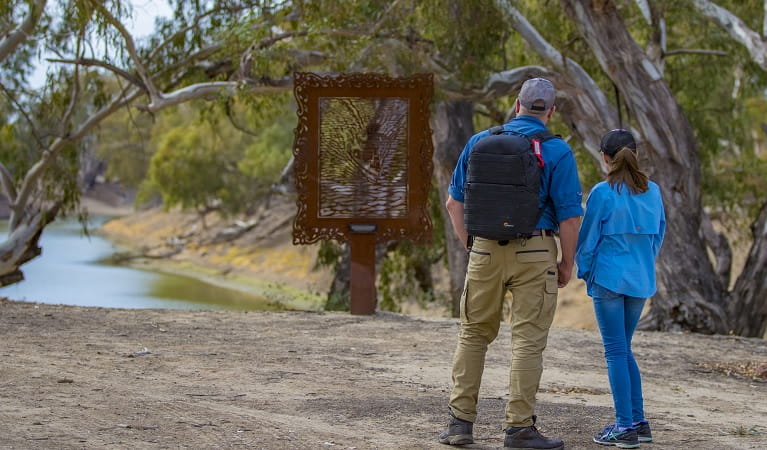Toorale National Park
Overview
Explore the vast floodplain and beautiful rivers of outback NSW near Bourke on a car tour of Toorale National Park and State Conservation Area. You’ll enjoy great fishing and birdwatching.
Read more about Toorale National Park
Experience an outback adventure at Toorale National Park and State Conservation Area (SCA). Awe-inspiring skies, dramatic sunsets and starry nights under Australian floodplain landscapes are just a few things you can enjoy while riverside camping at Darling River campground (Yapara Paaka Thuru). Picnic by the river bank to the sight and sound of birds at Many Big Rocks picnic area (Karnu Yalpa).
Best visited between April and November, few places offer the rare opportunity to see the floodplain landscape come to life after rain like Toorale National Park and SCA. Located at the junction of Warrego and Darling rivers, the seasonal wetlands offer an abundance of birdlife, with ibis, pelicans, as well as iconic brolgas.
This park lies within the traditional lands of Kurnu-Baakandji People. You can learn about their culture as well as the historic significance of this region on a Discovery tour. It’s the perfect addition to an outback tour, taking in neighbouring parks such as Gundabooka National Park.
Local alerts
For the latest updates on fires, closures and other alerts in this area, see https://www.nationalparks.nsw.gov.au/visit-a-park/parks/toorale-national-park/local-alerts
Contact
- in the Outback NSW region
Toorale National Park and SCA is always open, but may have to close at times due to poor weather or fire danger.
-
-
Bourke office
02 6830 0200
Contact hours: Monday to Friday, 8.30am to 4.30pm. - 51-53 Oxley Street, Bourke NSW 2840
-
Email: npws.bourke@environment.nsw.gov.au
-
Bourke office
Visitor info
All the practical information you need to know about Toorale National Park.
Map

Map legend

Getting there and parking
From Bourke:
- Travel 10.5km north from Bourke on Hungerford Road
- Continue for 21.5km and turn left at the sign to Louth, onto the unsealed Toorale Road (Rural Local Road 10).
- Drive for 38km and, after crossing a stock grid, you’ll see a Toorale entrance sign.
From Louth:
- Cross the bridge over the Darling River and travel 30km on the unsealed Toorale Road (Rural Local Road 10) towards Bourke.
Parking
- Darling River campground (Yapara Paaka Thuru) See on map
- Many Big Rocks picnic area (Karnu Yalpa) See on map
- Toorale Homestead precinct (Yarramarra) See on map
Road quality
- Unsealed roads
Vehicle access
- All roads require 4WD vehicle
By bike
Check out the Bicycle information for NSW website for more information.
By public transport
Visit the NSW country transport info website for more information.
Best times to visit
There are lots of great things waiting for you in Toorale National Park. Here are some of the highlights:
Autumn
Enjoy the wide open spaces under clear blue autumn skies.
Spring
A great time to see outback wildflowers and emu chicks and make the most of some excellent birdwatching opportunities.
Summer
Escape the heat and relax beside Darling River as you enjoy a spot of fishing among natural surroundings.
Winter
It’s the best time to explore the wetlands after the autumn rains bring the vast natural floodplain back to life.
Weather, temperature and rainfall
Summer temperature
Average
21°C and 36°C
Highest recorded
48°C
Winter temperature
Average
4°C and 18°C
Lowest recorded
-3.5°C
Rainfall
Wettest month
February
Driest month
September
The area’s highest recorded rainfall in one day
197.6mm
Facilities
Maps and downloads
Prohibited
Pets
Pets and domestic animals (other than certified assistance animals) are not permitted. Find out which regional parks allow dog walking and see the pets in parks policy for more information.
Smoking
NSW national parks are no smoking areas.
Nearby towns
Bourke (70 km)
Around 50km north of Gundabooka National Park is the town of Bourke. Considered the "Gateway to the real outback", Bourke is home to around 3,000 people and has a range of places to eat, garages and services, and plenty of things to do.
Learn more
Toorale National Park is a special place. Here are just some of the reasons why:
The People of Darling River

This country between the Warrego and Darling rivers is of spiritual and cultural significance to Kurnu-Baakandji People. The name Baakandji comes from the word ‘paaka’, meaning ‘Darling River’, so Baakandji are the People belonging to Darling River. Take a Discovery tour to learn about the culture and heritage of the region as well as local bush tucker such as wild orange, quandongs, wild plum bush, wild bananas and bush tomatoes.
Inland rivers

Toorale National Park marks the junction of two mighty inland rivers and provides one of only a few opportunities to access the Darling and Warrego rivers. Set up camp on the Darling riverbank, or spend a leisurely day checking out the local wildlife, birdwatching and fishing.
Rich pastoral history

A relative newcomer to the national park family, Toorale was purchased in 2008. The large pastoral station and woolshed changed hands many times, and many people have a historic connection to Toorale, including Henry Lawson, who worked on the station for a short period during the 1890s.
- Toorale Homestead precinct (Yarramarra) Toorale Homestead precinct (Yarramarra) is a must-see for outback travellers near Bourke. Built on the lands of the Kurnu-Baakandji People, Toorale Station was once part of the world’s largest sheep station.
Birdwatching spectacular

After the rains, the vast natural floodplain springs to life and the wetlands bring an abundance of birdlife. A fabulous spot for birdwatching, bring your binoculars for the chance to see the iconic brolga, pink cockatoo, or the wide range of waterbirds such as the Australian pelican, pied cormorant and royal spoonbill.
Environments in this park
Education resources (1)
What we're doing
Toorale National Park has management strategies in place to protect and conserve the values of this park. View the detailed park and fire management documents.

